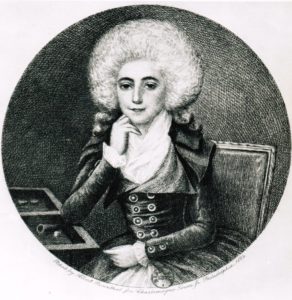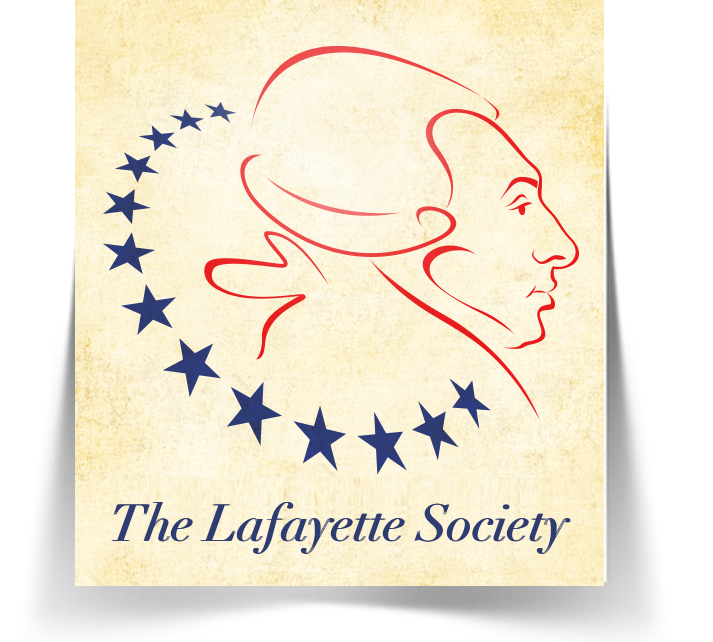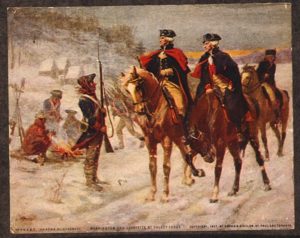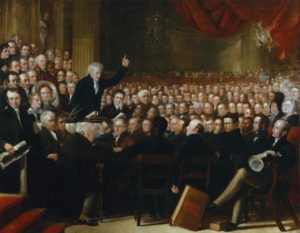Lafayette and Slavery
By Hank Parfitt, President of the Lafayette Society
In the United States, much of our understanding of Lafayette’s importance as a historical figure is focused on his roles as a military leader in the American Revolution and as a negotiator with France, our ally. Certainly, Americans should never forget the youthful French nobleman who came to our country’s aid as we struggled for independence. His contributions to mankind, however, extend far beyond his exploits in this country. It was after his return to France that Lafayette began his lifelong journey as an advocate for human rights and dignity.
When Lafayette returned home to France, much enamored of his newly adopted country and the republican values he had learned there, he was determined to put them into action. For one thing, he desired a more representative form of government for France’s people and he became a leading advocate for a constitutional monarchy. For another, he became an outspoken advocate for social reform in France, including Protestant freedom of religion and equal rights for all men. After election to the National Assembly in 1789, Lafayette wrote the draft for the Declaration of the Rights of Man and pursued legislation to promote his liberal ideals, including the abolition of slavery.
Precisely when Lafayette became an advocate for emancipation is not known. One important influence was his friend John Laurens from South Carolina, a fellow soldier in the Continental Army. Although his father was a slave owner in South Carolina, John was greatly influenced by Enlightenment ideas and he spoke to Lafayette often about the evils of slavery and proposed (unsuccessfully) to grant the enslaved their freedom in exchange for military service. Also, Lafayette became well-acquainted with an enslaved soldier by the name of James Armistead, who volunteered to serve with Lafayette during the siege of Richmond in 1781. Later that year, Lafayette paid Armistead to spy on General George Cornwallis by posing as a fugitive. The information Armistead gathered was invaluable to the American and French forces and contributed to their victory at Yorktown. In appreciation, Lafayette helped Armistead win his freedom after the war. Another major influence on Lafayette might have been, quite simply, the irony of fighting for freedom in a country where one-sixth of the population was enslaved. Lafayette was a man of logic and therefore unable and unwilling to accept such irony.Lafayette was also a man of action (some critics would say “precipitous action”) and not content merely to talk about emancipation. By 1783, he had hatched a plan to do something about slavery. Lafayette decided to purchase a plantation in the French colony of Cayenne on the northeastern coast of South America with the intention of freeing the enslaved workers through gradual manumission, which he hoped would demonstrate a way to end slavery. He would outlaw the whip, grant the enslaved more free time with their families, provide them with an education, and pay them a wage – actions that Lafayette thought would prepare the enslaved for freedom.
In a letter to George Washington, Lafayette expressed hope that his old mentor would join him in this venture…”such an example as yours might render it a general practice, and if we succeed in America, I will cheerfully devote a part of my time to render the method fashionable in the West Indies. If it be a wild scheme, I had rather be mad that way, than to be thought wise on the other tack.” Washington declined to join Lafayette in this enterprise, but he commended him for his generous spirit and ultimately provided for the freedom of those enslaved to him in his will.

Adrienne de Noailles, Lafayette’s wife, handled many of the business affairs for the Cayenne estate – from across the Atlantic Ocean.
In France, Lafayette appealed to Louis XVI for support of the Cayenne project but he also declined, even though the Marquis de Condorcet had heartily endorsed it. Still determined, Lafayette proceeded to purchase the properties entirely with his own funds. His agent in Cayenne bought two small sugar plantations in 1786 that were converted to the cultivation of spices, which required neither the back-breaking work nor deadly labor practices of sugar production. Far from acquiring a plantation to profit from the labors of the enslaved, Lafayette purchased the plantation to demonstrate to the French and all slaveholding powers a possible path toward emancipation and he was willing to spend considerable sums to do so. Lafayette is one of the strongest examples of a European who rooted their abolitionism in a commitment to universal liberty and the dignity of all; in this he presents a marked contrast to certain later white abolitionists who were motivated by fears of miscegenation and who advocated a policy of deportation (“colonization”).
The Cayenne project started slowly – the purchased lands proved unproductive, additional land acquisitions had to be made, the first property manager died – but by 1791 there were 500 new clove trees under cultivation by an estimated 70 enslaved workers and family members who came with the property. Before Lafayette’s plan could be implemented fully, however, the Revolutionary government of Robespierre ascended to power. Supporters of a constitutional monarchy were facing exile or death. Lafayette himself escaped France under threat of death in August of 1792, only to be imprisoned in present day Austria by royal authorities fearful that he might promote revolutionary ideas in their own country. While in prison, the Revolutionary government of France seized all of his property in South America, including the enslaved workers. They would later receive formal emancipation from the French government in the mid-1790’s, only to have Napoleon Bonaparte rescind it. This reversal prompted rebellions of the enslaved in Cayenne against the French Empire.
Although Lafayette could not see his plan for gradual manumission implemented, he became an inspiration and a hero to black and white abolitionists such as McCune Smith in New York, Lewis Hayden and William Cooper Nell in Boston, Senator Charles Sumner of Massachusetts, and Thomas Clarkson and Granville Sharp in England. In his newspaper, Frederick Douglass quoted letters by George Washington praising Lafayette for the Cayenne plan. These men considered Lafayette a “true abolitionist” because he advocated for racial equality as well as emancipation. They easily recognized him as different from “antislavery advocates” who deplored many aspects of slavery but whose chief aim was to preserve the Union and whose concept of equality was limited to white men like themselves. They certainly had no difficulty making a distinction between Lafayette, who purchased a plantation and the enslaved workers there in order to free them, and those who owned the enslaved for profit.Long after his death, Lafayette was quoted by abolitionists in their speeches and writings. Charles Sumner, for example, used his words to rally popular sentiment in the Northern states against a compromise with the South during the secession crisis. Quoting from a 1786 letter from Lafayette to John Adams, he wrote: “In the cause of my black brethren, I feel myself warmly interested and most decidedly side against the white part of mankind. Whatever be the complexion of the enslaved, it does not, in my opinion, alter the complexion of the crime which the enslaver commits, a crime much blacker than any African face.” Another common quote by abolitionists was drawn from Thomas Clarkson, who said that Lafayette had told him “I would never have drawn my sword in the cause of America, if I could have conceived that thereby I was founding a land of slavery.” Because Lafayette was respected and admired so greatly in America, these were powerful words that undoubtedly encouraged support for a war to free the enslaved.
Lafayette’s opposition to slavery, which began when he was a very young man, was truly remarkable for a privileged nobleman in the 18th– century. More remarkable was his willingness to commit himself, his fortunes, and his reputation to positive action that might offer a way to end slavery.
Finally, and perhaps the most remarkable thing of all, was his absolute, unwavering stance on this divisive issue. As Charles Sumner said, Lafayette was “one who early consecrated himself to Human Rights, and throughout a long life became their representative, knight-errant, champion, hero, missionary, apostle – who strove in this cause as no man in history has ever striven – who suffered for it as few have suffered, and whose protracted career… is conspicuous for the rarest fidelity, the purest principle, and the most chivalrous courage, whether civil or military.”
Note: The author is grateful to Dr. Robert D. Taber, Professor of History at Fayetteville State University, for his advice and for editing this article.
References for this article are from A True Friend of the Cause: Lafayette and the Antislavery Movement, edited by Diane Shaw and published by The Grolier Club of New York City and Lafayette College in 2016 to accompany an exhibition by the same name at the Grolier Club. A copy of this illustrated book may be obtained at City Center Gallery & Books (112 Hay St., Fayetteville, NC 28301; phone 910-678-8899; email citycentergallery@embarqmail.com).
More information is available at the Lafayette College online exhibit entitled “Lafayette and Slavery.”


![[Frederick Douglass, head-and-shoulders portrait, facing right]; Digital ID: (digital file from b&w film copy neg.) cph 3a18122 http://hdl.loc.gov/loc.pnp/cph.3a18122; Reproduction Number: LC-USZ62-15887 (b&w film copy neg.); Repository: Library of Congress Prints and Photographs Division Washington, D.C. 20540 USA Image: Frederick Douglass](https://www.lafayettesociety.org/wp-content/uploads/2018/06/Frederick_Douglas_from_LOC-239x300.jpg)
![[Charles Sumner, Senator from Massachusetts, Thirty-fifth Congress, half-length portrait]; Digital ID: (digital file from original item) ppmsca 26559 http://hdl.loc.gov/loc.pnp/ppmsca.26559; Reproduction Number: LC-DIG-ppmsca-26559 (digital file from original item); Repository: Library of Congress Prints and Photographs Division Washington, D.C. 20540 USA Image: Charles Sumner](https://www.lafayettesociety.org/wp-content/uploads/2018/06/Charles_Sumner_from_LOC_cropped-275x300.jpg)
